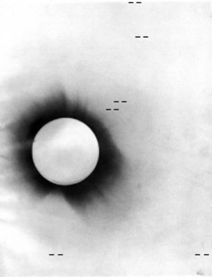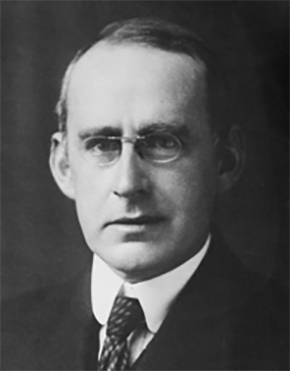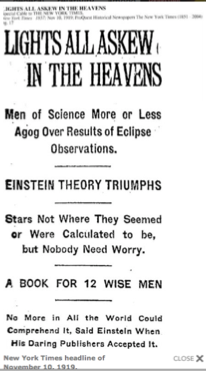WHAT’S UP? A Relative Eclipse
By Lou Mayo
Around the turn of the century (1900 that is), physics got weird. In fact, our whole understanding of the universe got weird. With the advent of quantum physics and relativity, our ideas about everything from time and space to causality were thrown into doubt and eventually broken.
So it was when, in 1905, Albert Einstein published his work on special relativity which stated that the laws of physics were the same for all observers in an inertial (constant velocity) frame of reference and that the speed of light in a vacuum was independent of the motion of an observer.
It took Einstein 10 more years to publish his theory of General Relativity which included accelerating reference frames and concluded that massive objects distort space-time. The force of gravity then was to be reimagined as the warping of space-time (the concept of independent space and time also got the boot) and not as an actual force at a distance.
His theories met with both acclaim and skepticism but were essentially untestable. That is until 1919 when British astronomer, Sir Arthur Eddington of Cambridge University, observed a total solar eclipse from the island of Príncipe off the west coast of Africa.
The sun was in the constellation Taurus and as darkness fell, a few stars in the Hyades cluster could be seen near the limb of the sun. Einstein’s theory of General Relativity (often just called GR) predicted that the apparent positions of stars observed near the sun would be shifted as their light rolled around the curved space near the massive sun. Eddington took photographs of the sun during totality and carefully measured the positions of these stars. He then compared their positions to positions at night, away from the influence of the sun’s mass. His analysis concluded that the stars did indeed appear to shift positions and by the amount Einstein’s theory predicted. The experiment was repeated during the total solar eclipse of 1922, 1953, and 1972. All reported similar results. Of his historic observations, Eddington wrote:
Oh leave the Wise our measures to collate
One thing at least is certain, LIGHT has WEIGHT,
One thing is certain, and the rest debate –
Light-rays, when near the Sun, DO NOT GO STRAIGHT.








